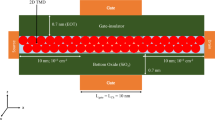Abstract
We have developed a self-consistent quantum mechanical Monte Carlo device simulator that takes electron transport in quantized states into consideration. Two-dimensional quantized states in MOSFET channels are constructed from one-dimensional solutions of the Schrödinger equation at different positions along the channel, and the Schrödinger and Poisson equations are solved self-consistently in terms of electron concentration and electrostatic potential distribution. The channel electron concentration, velocity and drain currents are calculated with the one particle Monte Carlo approach incorporating the intra-valley acoustic phonon and inter-valley phonon scattering mechanisms. This simulator was applied to a 70 nm n-MOSFET transistor, and we found that current mostly flows through the lowest subband and transport is quasi-ballistic near the source junction. To quantitatively estimate the performance of advanced devices, we have developed an inversion carrier transport simulator based on a full-band model. Our simulation method enables us to evaluate device characteristics and analyze the transport properties of ultra-small MOSFETs.
Similar content being viewed by others
References
C. Jungemann, A. Edmunds, and W.L. Engl, Solid State Electronics, 36, 1529 (1993).
M.V. Fiscetti and S.E. Laux, Phys. Rev. B, 48, 2244 (1992).
S. Kumashiro and I. Yokota, InternationalWorkshop on Numerical Modeling of Processes and Devices for Integrated Circuits, (1994), pp. 167.
A.S. Spinelli, A. Benvenuti, and A. Pacelli, IEEE Trans. Electron Devices, 45, 1342 (1998).
S. Yamakawa, H. Ueno, K. Taniguchi, C. Hamaguchi, K. Miyatsuji, K. Masaki, and U. Ravaioli, J. Appl. Phys., 79 (1996), 911.
P.J. Price, Ann. Phys., 133, 217 (1981).
D.K. Ferry, Surface Sci., 57, 218 (1976).
S.C. Williams, K.W. Kim, and W.C. Holton, IEEE Trans. Electron Devices, 1864, 47 (2000).
M.J. van Dort, P.H. Woerlee, A.J. Walker, C.A.H. Juffermans, and H. Lifka, IEEE Trans. Electron Devices, ED-39, 932 (1992).
A. Pacelli, A.S. Spinelli, and L.M. Perron, IEEE Trans. Electron Devices, 46, 383 (1999).
H. Takeda, N. Mori, and C. Hamaguchi, J. Comp. Electronics, 1, 467 (2002).
H. Nakatsuji, Y. Kamakura, and K. Taniguchi, IEDM Tech. Dig., 727 (2002).
S. Takagi, A. Toriumi, M. Iwase, and H. Tango, IEEE Trans. Electron Devices, 41, 2363 (1994).
Author information
Authors and Affiliations
Rights and permissions
About this article
Cite this article
Ezaki, T., Werner, P. & Hane, M. Self-Consistent Quantum Mechanical Monte Carlo MOSFET Device Simulation. Journal of Computational Electronics 2, 97–103 (2003). https://doi.org/10.1023/B:JCEL.0000011406.20864.06
Issue Date:
DOI: https://doi.org/10.1023/B:JCEL.0000011406.20864.06




